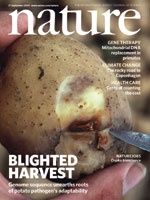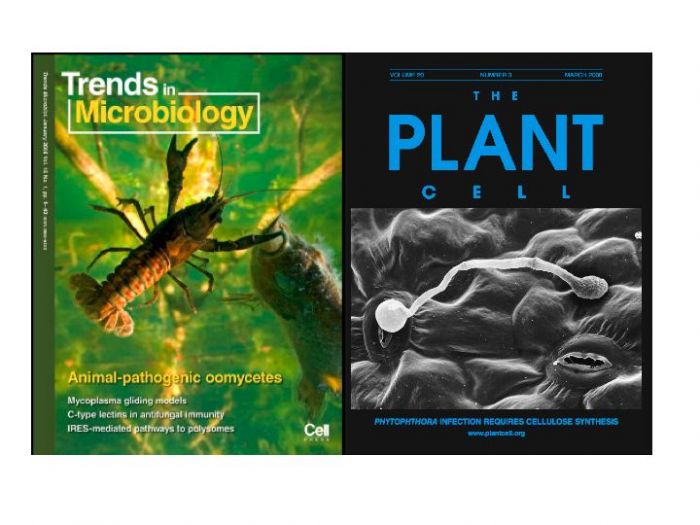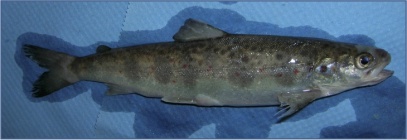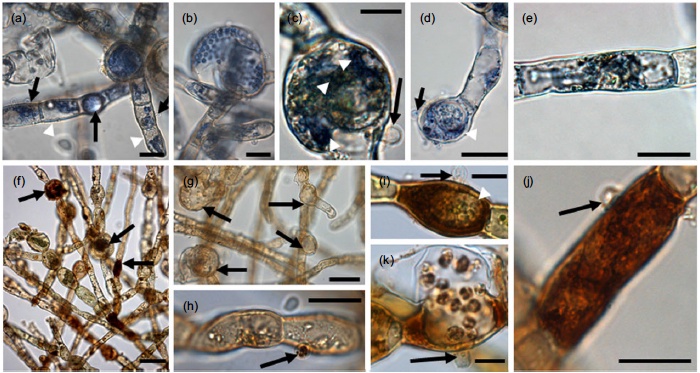
MSc (Wageningen, The Netherlands, 1993) PhD (Wageningen, The Netherlands, 2000)
Chair in Mycology
- Email Address
- p.vanwest@abdn.ac.uk
- Telephone Number
- +44 (0)1224 437327
- Office Address
Office 2:33, Lab 2:39
Aberdeen Oomycete Laboratory
College of Life Sciences and Medicine
Institute of Medical Sciences
Foresterhill
Aberdeen
AB25 2ZD- School/Department
- School of Medicine, Medical Sciences and Nutrition
Biography
Prof. Dr. Ir. Pieter van West is a past Royal Society University Research Fellow. He is Director of the International Centre for Aquaculture Research and Development (ICARD) at the University of Aberdeen, Board member of the Sustainable Aquaculture Innovation Centre (SAIC), Fellow of the Royal Society of Edinburgh and he was President of the British Mycological Society 2017-2018) .
His current research programme focuses on oomycete biology. Several economically and environmentally important oomycetes, or watermoulds, are studied at most disciplinary levels (taxonomy, ecology, epidemiology, biochemistry and cellular and molecular biology and especially host-microbe interactions). He is particularly interested in developing novel methods to control oomycete pathogens.
The animal pathogenic oomycetes under investigation are Saprolegnia parasitica, Saprolegnia australis, Saprolegnia diclina, Aphanomyces spp. and Halioticida spp.
The plant pathogenic species include mainly Phytophthora infestans and several Pythium spp. and the algal pathogenic species include Eurychasma dicksonii, Olpidiopsis spp., Anisolpidium spp. and Maulinia spp.
Memberships and Affiliations
Director of the International Centre for Aquaculture Research and Development (ICARD)
Fellow of the Royal Society of Edinburgh
Board member of the Sustainable Aquaculture Innovation Centre (SAIC)
Past President of the British Mycological Society
Editorial Board member of Fungal Biology
Editorial Board member of Fungal Biology Reviews
Research Overview
Fundamental molecular processes in Oomycete pathogens
The group of oomycete pathogens cause destructive diseases of thousands of (commercially important) plant species and fish. These so-called watermoulds have many fungus-like characteristics, but are not true-fungi. In fact, they are closely related to kelp and diatoms.
One particular oomycete, Phytophthora infestans, the causal agent of potato late blight, generates global yield losses estimated to exceed over £3 billion annually, making it one of the most important biotic constraints to global food production. It is probably the most destructive plant pathogen in human history, as it caused tremendous human suffering in the mid 1840's due to failed potato crops in Ireland and the UK.
One of the most destructive oomycete pathogens on fish is Saprolegnia parasitica. It is endemic to all fresh water habitats around the world and is partly responsible for the decline of natural populations of salmonids and other fresh water fish. Today, losses in the salmon aquaculture business in Scotland alone are estimated at several millions of pounds annually.

Despite their economic importance, little is known about the molecular mechanisms accounting for the success of Oomycetes as plant or fish pathogens, or the fundamental molecular processes underlying their development. My research program aspires to identify molecular characteristics that are essential for the development and pathogenesis of Phytophthora, Pythium and Saprolegnia species.
Work mainly focuses on the isolation and functional characterisation of genes encoding recognition molecules and stage-specific proteins to enable
- understanding and unravelling fundamental molecular processes in Oomycetes
- the detection of molecular targets for novel control strategies, possibly directed against a variety of Oomycete pathogens.

Current Research
1 Identification and functional characterisation of zoospore specific proteins from oomycetes via genomic, transcriptomic and proteomics approaches (Figure 1).

Figure 1. Zoospores are released from a sporangium of Saprolegnia parasitica (taken from van West, 2006)
2 Identification and functional characterisation of proteins from Saprolegnia parastica, a fish pathogen of salmonids and other fresh water fish (Figure 2), that are essential for development and pathogenicity.

Figure 2. Saprolegnia infection on pre-smolt salmon.
3 Investigating the mechanism of Phytophthora and Saprolegnia protein translocation into the host cells (Figure 3).

Figure 3 Oomycete effector translocation (Image taken from Wawra et al., 2012 Current Opinion in Microbiology doi:10.1016/j.mib.2012.10.008).
4 Research into oomycete-insect interactions

Figure 4 Saprolegnia infections of waterborne insects (Image taken from Sarowar et al. 2013 Fungal Biology 117: 752-763).
5 Research into oomycete-algae interactions.

Figure 5 Eurychasma infections in Ectocarpus (Image taken from Strittmatter et al., 2015, Plant Cell & Environment doi: 10.1111/pce.12533).
6 Discovering and describing novel oomycete species

Figure 6 Oospores of Pythium polare, a pathogen of moss from the arctic and antarctic regions (Image taken from Tojo et al. 2012, Fungal Biology doi:10.1016/j.funbio.2012.04.005).
Teaching Responsibilities
Eukaryotic Microbiology lectures in course BI25M5 (Microbes, Infection & Immunity)
Molecular Plant Pathology lectures in course AG3816 (Biology and Ecology of Plant Disease)
Page 3 of 3 Results 101 to 128 of 128
New insights into animal pathogenic oomycetes
Phillips, A. J., Anderson, V. L., Robertson, E. J., Secombes, C. J., Van West, P.Trends in Microbiology, vol. 16, no. 1, pp. 13-19Contributions to Journals: Articles- [ONLINE] DOI: https://doi.org/10.1016/j.tim.2007.10.013
A translocation signal for delivery of oomycete effector proteins into host plant cells
Whisson, S. C., Boevink, P. C., Moleleki, L., Avrova, A. O., Morales, J. G., Gilroy, E. M., Armstrong, M. R., Grouffaud, S., van West, P., Chapman, S., Hein, I., Toth, I. K., Pritchard, L., Birch, P. R. J.Nature, vol. 450, no. 7166, pp. 115-118Contributions to Journals: Articles- [ONLINE] DOI: https://doi.org/10.1038/nature06203
Zoospore development in the oomycetes
Walker, C., van West, P.Fungal Biology Reviews, vol. 21, no. 1, pp. 10-18Contributions to Journals: Articles- [ONLINE] DOI: https://doi.org/10.1016/j.fbr.2007.02.001
Proteomics of plant interacting oomycetes and fungi
Bruce, C. R., Van West, P., Grenville-Briggs, L. J.Microbial Proteomics: Functional biology of whole organisms. Humphery-Smith, I., Hecker, M. (eds.). Wiley-Blackwell, pp. 271-283, 12 pagesChapters in Books, Reports and Conference Proceedings: ChaptersProteomic studies of plant-pathogenic oomycetes and fungi
Bruce, C. R., Van West, P., Grenville-Briggs, L. J.Methods of Biochemical Analysis, vol. 51, no. 1, pp. 271-283Contributions to Journals: Articles- [ONLINE] View publication in Scopus
Expressed sequence tags from the oomycete fish pathogen Saprolegnia parasitica reveal putative virulence factors
Torto-Alalibo, T., Tian, M., Gajendran, K., Waugh, M. E., Van West, P., Kamoun, S.BioMed Central Microbiology, vol. 5, pp. 46Contributions to Journals: ArticlesThe biotrophic stages of oomycete-plant interactions
Grenville-Briggs, L. J., Van West, P.Advances in Applied Microbiology. Laskin, A. I., Bennett, J. W., Gadd, G. M. (eds.). Elsevier Academic Press, pp. 217-243, 26 pagesChapters in Books, Reports and Conference Proceedings: ChaptersElevated amino acid biosynthesis in Phytophthora infestans during appressorium formation and potato infection
Grenville-Briggs, L. J., Avrova, A. O., Bruce, C. R., Williams, A., Whisson, S. C., Birch, P. R. J., van West, P.Fungal Genetics and Biology, vol. 42, no. 3, pp. 244-256Contributions to Journals: Articles- [ONLINE] DOI: https://doi.org/10.1016/j.fgb.2004.11.009
Potassium homeostatsis influences the locomotion and encystment of zoospores of plant pathogenic oomycetes
Appiah, A. A., Van West, P., Osborne, M. C., Gow, N. A. R.Fungal Genetics and Biology, vol. 42, no. 3, pp. 213-223Contributions to Journals: Articles- [ONLINE] DOI: https://doi.org/10.1016/j.fgb.2004.11.003
- [OPEN ACCESS] http://aura.abdn.ac.uk/bitstream/2164/2440/1/Appiah_et_al_revised.doc
A method for double-stranded RNA-mediated transient gene silencing in Phytophthora infestans
Whisson, S. C., Avrova, A. O., Van West, P., Jones, J. T.Molecular Plant Pathology, vol. 6, no. 2, pp. 153-163Contributions to Journals: Articles- [ONLINE] DOI: https://doi.org/10.1111/j.1364-3703.2005.00272.x
Functional characterisation of oomycete genes with double stranded RNA mediated silencing
van West, P., Avrova, A. O., Grenville-Briggs, L. J., Walker, C., Jones, J. T., Whisson, S. C.Contributions to Conferences: AbstractsLarge-scale gene discovery in the oomycete Phytophthora infestans reveals likely components of phytopathogenicity shared with true fungi
Randall, T. A., Van West, P., Judelson, H. S.Molecular Plant-Microbe Interactions, vol. 18, no. 3, pp. 229-243Contributions to Journals: ArticlesProteomic approaches to investigate the infection process of Phytophthora infestans.
Van West, P.Contributions to Conferences: AbstractsA Ga subunit controls zoospore motility and virulence in the potato late blight pathogen Phytophthora infestans
Latijnhouwers, M., Ligterink, W., Vleeshouwers, V., van, W. P., Govers, F.Molecular Microbiology, vol. 51, no. 4, pp. 925-936Contributions to Journals: Articles- [ONLINE] DOI: https://doi.org/10.1046/j.1365-2958.2003.03893.x
- [ONLINE] http://europepmc.org/abstract/med/14763970
Functional characterisation of appressoria specific proteins from Phytophthora infestans
Grenville-Briggs, L., Taylor, C. R., Williams, A., Avrova, A. O., Birch, P. R. J., van West, P.Contributions to Conferences: AbstractsMolecular genetic analysis of zoospore-root interactions in a plant pathogenic oomycete.
Van West, P., Appiah, A. A., Gow, N. A. R.Contributions to Conferences: AbstractsThe Phytophthora infestans - potato interaction
Van West, P., Vleeshouwers, V. G.In: Plant Pathogen Interactions (ed. Talbot,N. J.) Chapter 9, Blackwell Scientific PublishersChapters in Books, Reports and Conference Proceedings: ChaptersEST mining and functional expression assays identify extracellular effector proteins from the plant pathogen Phytophthora
Torto, T. A., Li, S., Styer, A., Huitema, E., Testa, A., Gow, N. A. R., Van West, P., Kamoun, S.Genome Research, vol. 13, no. 7, pp. 1675-1685Contributions to Journals: Articles- [ONLINE] DOI: https://doi.org/10.1101/gr.910003
Phytophthora since Berkeley
Van West, P.Contributions to Conferences: Other ContributionsProteomic analysis of asexual development of Phytophthora palmivora
Shepherd, S. J., Van West, P., Gow, N. A. R.Mycological Research, vol. 107, no. Pt 4, pp. 395-400Contributions to Journals: Articles- [ONLINE] DOI: https://doi.org/10.1017/S0953756203007561
Proteomic approaches to investigate the infection process of Phytophthora infestans
Van West, P., Appiah, A. A., Birch, P. R. J., Gow, N. A. R., Grenville-Briggs, L. J., Li, S., Bruce, C., Williams, A.Contributions to Conferences: AbstractsOomycete plant pathogens use electric fields to target roots
Van West, P., Morris, B. M., Reid, B., Appiah, A. A., Osborne, M. C., Campbell, T. A., Shepherd, S. J., Gow, N. A. R.Molecular Plant-Microbe Interactions, vol. 15, no. 8, pp. 790-798Contributions to Journals: Articles- [ONLINE] DOI: https://doi.org/10.1094/MPMI.2002.15.8.790
Identification of stage specific proteins in Phytophthora spp.
Van West, P.Contributions to Conferences: AbstractsGreen fluorescent protein (GFP) as a reporter gene for the plant pathogenic oomycete Phytophthora palmivora
van West, P., Reid, B., Campbell, T. A., Sandrock, R. W., Fry, W. E., Kamoun, S., Gow, N. A. R.FEMS Microbiology Letters, vol. 178, pp. 71-80Contributions to Journals: ArticlesInternuclear gene silencing in Phytophthora infestans
van West, P., Kamoun, S., van 't Klooster, J. W., Govers, F.Molecular Cell, vol. 3, pp. 339-348Contributions to Journals: ArticlesRic1, a Phytophthora infestans gene with homology to stress-induced genes
van West, P., Kamoun, S., van't Klooster, J. M., Govers, F.Current Opinion in Genetics & Development, vol. 36, pp. 310-315Contributions to Journals: ArticlesQuantification of late blight resistance of potato using transgenic Phytophthora infestans expressing beta-glucuronidase.
Kamoun, S., van West, P., Govers, F.European journal of plant pathology., vol. 104, no. 5, pp. 521-525Contributions to Journals: Articles- [ONLINE] DOI: https://doi.org/10.1023/a:1008698620906
- [ONLINE] http://europepmc.org/abstract/AGR/IND21637822
Resistance of Nicotiana benthamiana to Phytophthora infestans is mediated by the recognition of the elicitor protein INF1
Kamoun, S., Van West, P., Vleeshouwers, V. G., De Groot, K. E., Govers, F.Plant Cell, vol. 10, no. 9, pp. 1413-1425Contributions to Journals: Articles- [ONLINE] DOI: https://doi.org/10.1105/tpc.10.9.1413
- [ONLINE] View publication in Scopus
